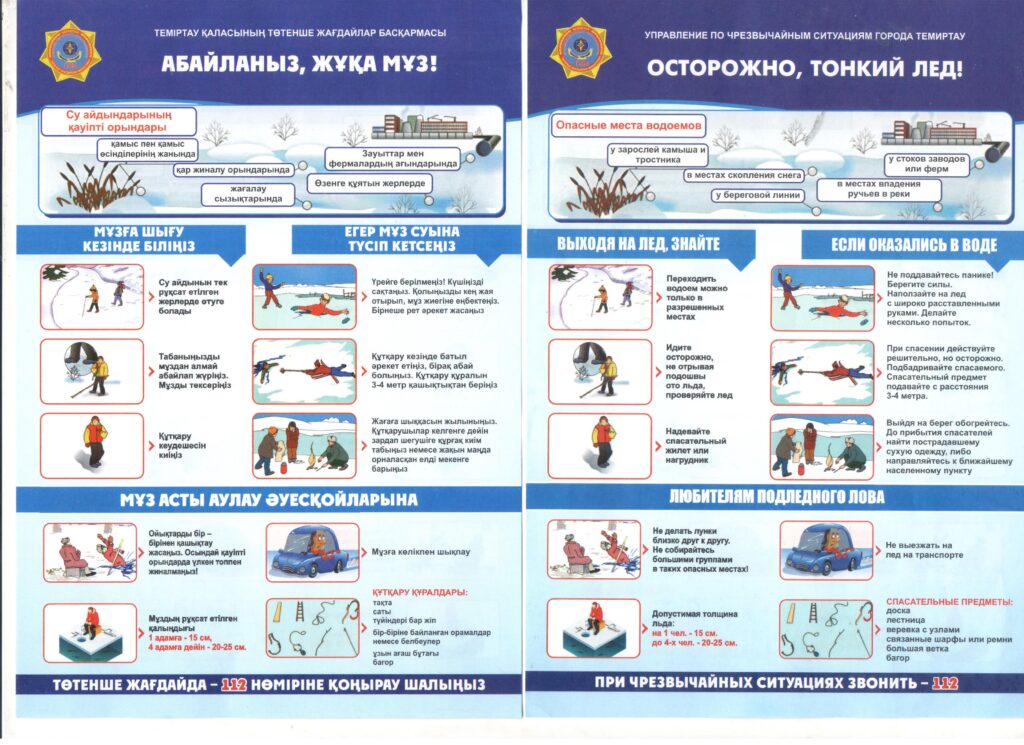according to the actions of the population in winter
In winter, various types of emergencies may occur. Winter in most regions of Kazakhstan is a truly severe natural phenomenon with heavy snowfall, blizzard, frost and ice. In order to prevent accidents, it is necessary to follow the rules of conduct in winter.
GOING ON THE ROAD IN WINTER:
follow the weather information;
before leaving the house, take a look at the thermometer;
dress according to the weather – do not neglect extra clothes;
do not leave children unattended;
constantly monitor your condition – do not allow hypothermia and especially frostbite;
do not create situations in which it is possible to receive a cold injury;
do not stay long at a party. Do not abuse alcohol – it dulls the reaction and leads to erroneous decisions.
CLOTHING IN WINTER:
A simple rule: air retains heat. So the more layers of air there are, the better. However, keep in mind that being dressed like cabbage is also bad — it will restrict movement (moving less means freezing more). Contrary to a common myth, thick woolen clothes are not the best clothes in case of cold weather, choose any not too thick woolly fabrics — they retain air well, and therefore heat. Try to keep your neck and wrists insulated, since it is through these parts of the body that heat is lost most intensively in the cold. Do not forget that mittens retain heat better than gloves. Use scarves – they protect well from the cold and never go out of fashion.
The headdress must be well fitted, the ears must be covered. The best shoes for severe frosts are felt boots and fur shoes, such as boots, ugg boots.
WHEN GOING ON THE ROAD BY CAR, DO NOT FORGET:
warm clothes and a small supply of provisions;
documents and a phone charger;
snow removal tool;
fill up the full tank;
Always stay on the road on the way.
If A BLIZZARD CAUGHT YOU on the road IN A CAR …
try not to deviate from it, stick to the highway, asphalt, telegraph and electric poles, because they are least susceptible to skidding;
when you stop on the road, sound an alarm with intermittent beeps, lift the hood or hang a bright cloth on the antenna, wait for help in the car. At the same time, you can leave the engine running by opening the window slightly to provide ventilation and prevent carbon monoxide poisoning.
if there are several people on the way (in several cars), it is advisable to get together and use one car for shelter, the water from the engines must be drained;
position the car with the hood facing the wind, insulate yourself as much as possible, the oven should not work all the time (save fuel). In a swept-up car, if you want to keep warm, start the oven only after clearing the exhaust pipe (otherwise you will die from exhaust fumes before you freeze);
-if the car is threatened with falling asleep with a snow mass, periodically open one of the doors, move it away, break the snowdrift so that it does not wall up inside the cabin;
periodically open one of the doors, move it away, break the snowdrift so that it does not brace you inside the cabin;
have a stock of groceries in the car, a thermos of hot tea;
try not to stray far from the car, because in a strong blizzard, landmarks may be lost;
if you decide to wait for help, try not to sleep.
FIRST AID FOR FROSTBITE:
The first sign of frostbite is numbness of the frostbitten part of the body.
In case of frostbite: DO NOT warm the affected areas of the body with hot water or hot air, rub and massage with snow, but IT is NECESSARY to release the frostbitten part of the body from clothing, immerse it in warm (but not hot) water, keep it in water until redness and restoration of skin temperature, apply a sterile, dry bandage before visiting a doctor ( put cotton wool or gauze between your fingers), give a warm drink.
RULES OF CONDUCT IN CASE OF ICE:
If the weather forecast gives a message about ice or sleet, take measures to reduce the likelihood of injury, prepare suitable shoes.
-inspect the footpaths in front of you, avoid places of solid ice, wear low-heeled shoes with large notches on the sole.
-move carefully, taking your time, stepping on the entire sole. At the same time, the legs should be relaxed, the hands free. If you slip, sit down to lower the height of the fall. At the moment of falling, try to group up and roll over, soften the impact on the ground.
-do not stand close to the edge of the roadway at public transport stops, because when braking or starting from the bus, the minibus may carry over.
-be especially careful when crossing the street in the designated places. Do not start your movement until the vehicle stops completely.
GOING OUT ON THE ICE:
-pay attention to: your WELL-BEING, WEATHER CONDITIONS and THE STATE OF THE ICE SHEET;
-it is strictly forbidden to travel to the ice by motor transport;
-you should go out on the ice only IN STABLE FROSTS, when the ice cover reaches at least 20-30 cm;
-in places where industrial waters are discharged, THE ICE IS ALWAYS THINNER, there are GULLIES – TRAPS FOR FISHERMEN;
-strong winds, thaws are the SEPARATION or CHIPPING of ice FLOES from the total mass of ice;
-do not go fishing ALONE and at NIGHT, do not go far from the shore;
-when going out on the ice, have COMMUNICATION EQUIPMENT, a FLASHLIGHT or other means of signaling with you;
-fishing with a VEST or BIB on will help to maintain BUOYANCY when falling through the ice;
-A ROPE in a backpack or a CORD 15-20m long will help you in case of emergency;
-if you have fallen through the ice, then SPREAD your ARMS WIDE and do not lean on the thin edge of the ice, try to throw your feet on the ice;
-REMEMBER, once in icy water, a person FREEZES AND LOSES CONSCIOUSNESS after 20-30 minutes.
Your LOCATION on the reservoir should be known at HOME
The emergency phone number is 112.
Remember! A person is then stronger than the elements when he knows how to act correctly

